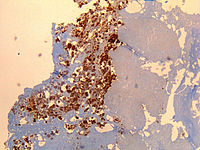
Photo from wikipedia
Coxiella burnetii is the causative bacterium of the zoonotic disease Q fever, which is recognised as a public health concern globally. Macropods have been suggested as a potential source of… Click to show full abstract
Coxiella burnetii is the causative bacterium of the zoonotic disease Q fever, which is recognised as a public health concern globally. Macropods have been suggested as a potential source of C. burnetii infection for humans. The aim of this cross-sectional study was to determine the prevalence of C. burnetii exposure in a cohort of Australian wildlife rehabilitators (AWRs) and assess Q fever disease and vaccination status within this population. Blood samples were collected from adult participants attending the Australian Wildlife Rehabilitation Conference in Sydney in July 2018. Participants completed a questionnaire at the time of blood collection. Antibody titres (IgG, IgA and IgM) against phase I and phase II C. burnetii antigens as determined by immunofluorescence assay, revealed that of the unvaccinated participants, 6.1% (9/147) had evidence of exposure to C. burnetii. Of the total participants, 8.1% (13/160) had received Q fever vaccination, four of whom remained seropositive at the time of blood collection. Participants reporting occupational contact with ruminants, were eight times more likely to have been vaccinated against Q fever, than those reporting no occupational animal contact (OR 8.1; 95% CI 1.85–45.08). Three AWRs (2%) reported having had medically diagnosed Q fever, two of whom remained seropositive at the time of blood collection. Despite the lack of association between macropod contacts and C. burnetii seropositivity in this cohort, these findings suggest that AWRs are approximately twice as likely to be exposed to C. burnetii, compared with the general Australian population. This provides support for the recommendation of Q fever vaccination for this potentially ‘at-risk’ population. The role of macropods in human Q fever disease remains unclear, and further research into C. burnetii infection in macropods including: infection rate and transmission cycles between vectors, macropods as reservoirs, other animals and humans is required.
Journal Title: One Health
Year Published: 2021
Link to full text (if available)
Share on Social Media: Sign Up to like & get
recommendations!